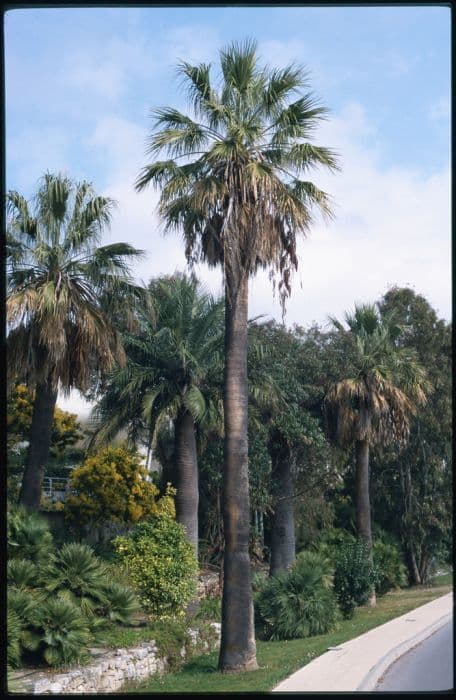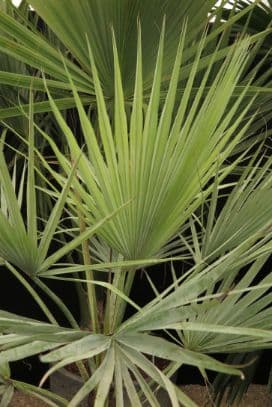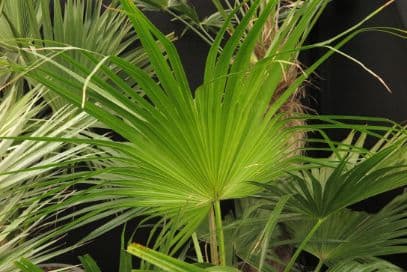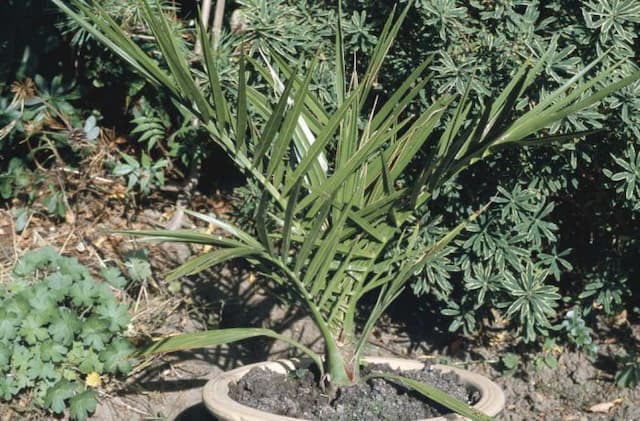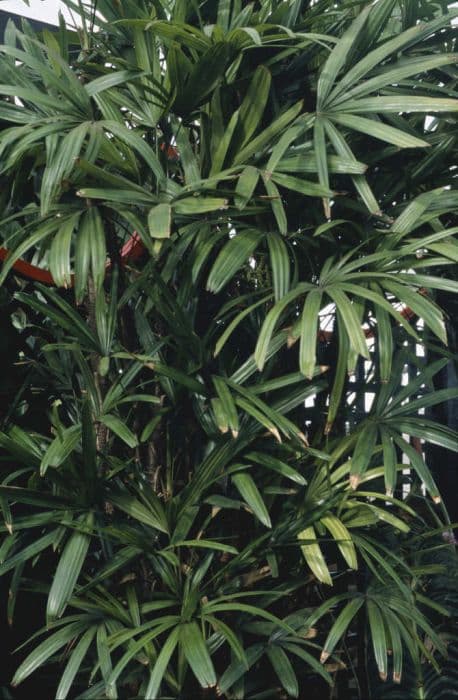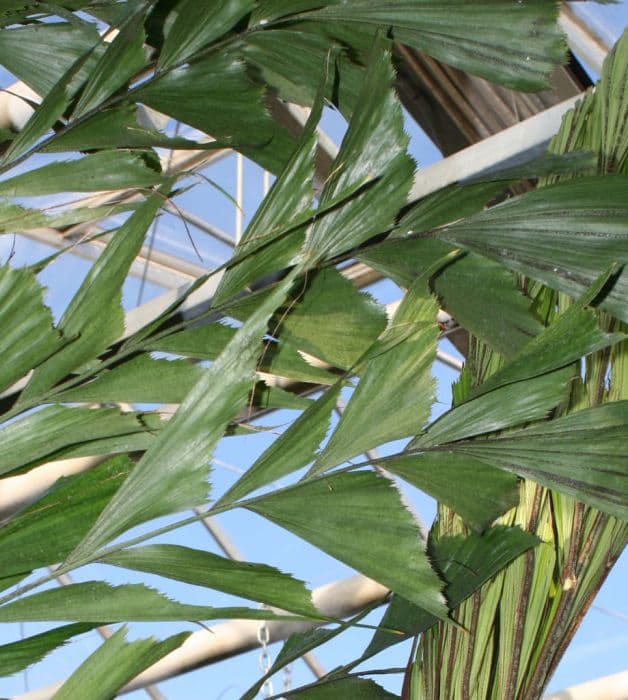Chilean Wine Palm Jubaea chilensis






ABOUT
The Chilean wine palm, known as Jubaea chilensis, is a species visually characterized by its robust, thick trunk that bears the scars of old leaf bases, creating a patterned and textured appearance. Topping this trunk is a crown of shiny, deep green leaves that are large, arching gracefully, and forming a rounded canopy. Each leaf is pinnate, meaning it resembles a feather in shape, with numerous leaflets growing on either side of a central stem. The leaflets themselves are linear-lanceolate, meaning they are long and narrow with a pointed tip, and they are grouped closely together, giving the leaves a full and lush look. During the blooming period, the Chilean wine palm produces inflorescences that are branched and arise from the axils of the leaves, holding clusters of small flowers. The flowers give way to fruits that start green and turn to a yellow or sometimes brownish color when ripe. These fruits are round and relatively small, looking somewhat like miniature coconuts. The overall appearance of the Chilean wine palm is one of majestic elegance, with its pronounced crown of leaves creating a silhouette that is instantly recognizable and often associated with tropical landscapes.
About this plant
 Names
NamesFamily
Arecaceae
Synonyms
Chilean Wine Palm, Chilean Palm, Chile Coconut Palm, Honey Palm
Common names
Cocos chilensis, Jubaea spectabilis, Micrococos chilensis, Molinaea micrococos.
 Toxicity
ToxicityTo humans
The Chilean Wine Palm is generally not considered toxic to humans. There are no well-documented cases or reports of poisoning by consuming parts of the Chilean Wine Palm.
To pets
The Chilean Wine Palm is not known to be toxic to pets. There are no specific symptoms of poisoning associated with this plant, as it is not considered poisonous to animals. Therefore, ingesting parts of the Chilean Wine Palm should not cause adverse health effects in pets.
 Characteristics
CharacteristicsLife cycle
Perennials
Foliage type
Evergreen
Color of leaves
Green
Flower color
Yellow
Height
80 feet [24 meters]
Spread
25 feet [7.6 meters]
Plant type
Palm
Hardiness zones
8
Native area
Chile
Benefits
 General Benefits
General Benefits- Ornamental Value: The Chilean wine palm is often used in landscaping due to its impressive stature and attractive, thick trunk.
- Climate Resilience: Being native to South America, it is well-suited for a variety of climates, including arid and semi-arid regions, making it a hardy addition to different landscapes.
- Shade Provider: Due to its large canopy, it provides ample shade, which can be beneficial in creating comfortable outdoor spaces and reducing local temperature extremes.
- Food Source: The sap of the Chilean wine palm is traditionally used to produce palm syrup, and its seeds can be eaten as nuts after roasting.
- Carbon Sequestration: Like all trees, it absorbs carbon dioxide, helping to mitigate climate change by removing this greenhouse gas from the atmosphere.
- Habitat for Wildlife: Its structure provides habitat and food for various species of birds, insects, and other wildlife, contributing to biodiversity.
- Cultural Significance: In its native range, the Chilean wine palm has cultural importance and is often featured in local traditions and folklore.
- Longevity: It is known for its longevity, which allows it to contribute to the ecosystem and serve its ornamental purpose for many generations.
- Low Maintenance: Once established, it requires relatively low care, making it a practical choice for public and private gardens.
 Medical Properties
Medical Properties- This plant is not used for medical purposes.
 Air-purifying Qualities
Air-purifying QualitiesThis plant is not specifically known for air purifying qualities.
 Other Uses
Other Uses- The sap from the Chilean Wine Palm can be fermented to create a sweet, alcoholic beverage historically enjoyed by indigenous peoples of Chile.
- The fronds are often used as thatch for roofing in traditional Chilean buildings and shelters.
- Wood from the Chilean Wine Palm is used in construction for flooring, cladding, and to make furniture, due to its durability and aesthetic appeal.
- The seeds can be ground to produce a flour that is used in local cuisine, especially for making a type of bread.
- The Chilean Wine Palm's large leaves are sometimes used in religious ceremonies and local festivals as a symbol of victory or peace.
- The trunk yields a sugar-rich syrup sometimes used as a natural sweetener in foods and drinks once boiled down.
- Fibers from the fronds are used to create baskets, hats, and other traditional crafts in Chile.
- The hollowed-out trunk can serve as a water channel or pipe in agricultural practices, attributing to its historical irrigation uses.
- Dried fronds of the palm can also be used as mulch or compost in gardens to enrich the soil and retain moisture.
- The striking appearance of the Chilean Wine Palm makes it a sought-after ornamental plant for landscapes and gardens.
Interesting Facts
 Feng Shui
Feng ShuiThe Chilean Wine Palm is not used in Feng Shui practice.
 Zodiac Sign Compitability
Zodiac Sign CompitabilityThe Chilean Wine Palm is not used in astrology practice.
 Plant Symbolism
Plant Symbolism- Endurance - Jubaea chilensis, commonly known as the Chilean Wine Palm, can live for many years, often reaching over a century in age. Its incredible lifespan symbolizes endurance and the ability to withstand time.
- Resilience - The Chilean Wine Palm grows slowly but can survive in tough conditions, symbolizing resilience in the face of adversity and the capacity to persist through challenges.
- Prosperity - Historically, the sap of the Chilean Wine Palm was used to produce a sweet syrup and an alcoholic beverage. This use brings the symbolism of prosperity and nourishment, as it provides food and drink.
- Rarity - As an endangered species, the Chilean Wine Palm represents rarity and the significance of conservation, symbolizing the preciousness of that which is at risk of being lost.
 Water
WaterThe Chilean Wine Palm should be watered deeply but infrequently to mimic its natural arid habitat. Young palms may require watering once a week, particularly during hot, dry periods. For mature palms, watering once every two to three weeks is sufficient. Each watering session should provide enough water to moisten the soil to a depth of 24 inches, which could be approximately 15 to 20 gallons depending on soil type and environmental conditions. Overwatering can lead to root rot, so it is important to let the soil dry out between sessions.
 Light
LightThe Chilean Wine Palm thrives in full sun exposure, so it is best planted in a location where it can receive at least six hours of direct sunlight daily. This palm does not tolerate shade well, as insufficient light can lead to weak growth and a thin canopy. Therefore, the ideal spot for the Chilean Wine Palm is in an open area, away from taller trees or structures that could block sunlight.
 Temperature
TemperatureThe Chilean Wine Palm is hardy and can withstand a range of temperatures, from as low as 20°F up to 100°F. However, the ideal temperature conditions for this tree would be between 50°F and 85°F, which encourages healthy growth and development. Although it is cold-tolerant, prolonged exposure to temperatures below 20°F can be detrimental to the palm's health.
 Pruning
PruningPruning the Chilean Wine Palm is generally done to remove dead or dying fronds, which can improve the appearance and health of the tree. The best time for pruning is in the spring, just before the growing season. It is not necessary to prune this palm frequently; once a year or even less is usually sufficient. Always use sterilized, sharp pruning tools to avoid damaging the trunk and to ensure clean cuts.
 Cleaning
CleaningNot needed
 Soil
SoilThe Chilean Wine Palm requires a well-draining soil mix with a pH of 6.1 to 7.8. A mixture of loam, sand, and organic matter such as peat or compost is beneficial. Ensure adequate drainage to prevent waterlogged conditions which can harm the plant.
 Repotting
RepottingChilean Wine Palms are slow-growing and have a large taproot, therefore it is only necessary to repot them every few years. It is important not to repot too often as this can disturb their growth.
 Humidity & Misting
Humidity & MistingThe Chilean Wine Palm is tolerant of various humidity levels, but prefers moderate to high humidity. It is adaptable but thrives in an environment that mimics its native coastal and valley habitats.
 Suitable locations
Suitable locationsIndoor
Place in bright light, away from drafts, water sparingly.
Outdoor
Full sun, protect from frost, water when dry, fertile soil.
Hardiness zone
8-12 USDA
 Life cycle
Life cycleThe Chilean wine palm (Jubaea chilensis) begins its life cycle with seed germination, which can be quite slow, often taking several months. Once germinated, the seedling stage follows, where the plant develops its primary leaves and begins to establish a root system. Juvenility in this palm can last many years, during which the plant slowly develops a bulky stem and a crown of pinnate leaves. Once it reaches maturity, which can take up to 60 years, the Chilean wine palm produces inflorescences with small, yellowish flowers, with separate male and female flowers usually on different trees (dioecious). Successful pollination leads to the growth of its fruit, small coconuts that contain the seeds for reproduction. The life span of Jubaea chilensis can exceed 100 years, after which the plant will die, completing its life cycle.
 Propogation
PropogationPropogation time
Spring-Early Summer
The Chilean Wine Palm (Jubaea chilensis) is typically propagated by seed, which stands as the most popular method for cultivating new plants. The best time to plant the seeds is in late winter to early spring when temperatures are mild. Fresh seeds have a higher germination rate and should ideally be soaked in water for 24-48 hours before planting. They are then sown in a well-draining soil mixture at a depth of approximately 1-2 inches (2.5-5 cm), under conditions that maintain consistent moisture and warmth. Germination can be slow, sometimes taking several months, and the growth rate of the seedlings is typically gradual. Young palms are then carefully nurtured until they are strong enough to be transplanted to their final growing location.


